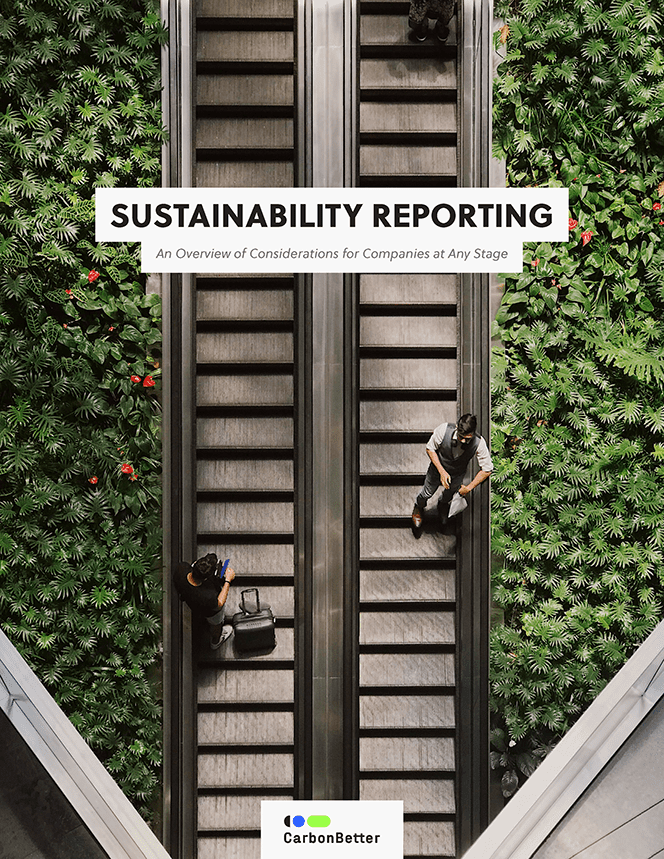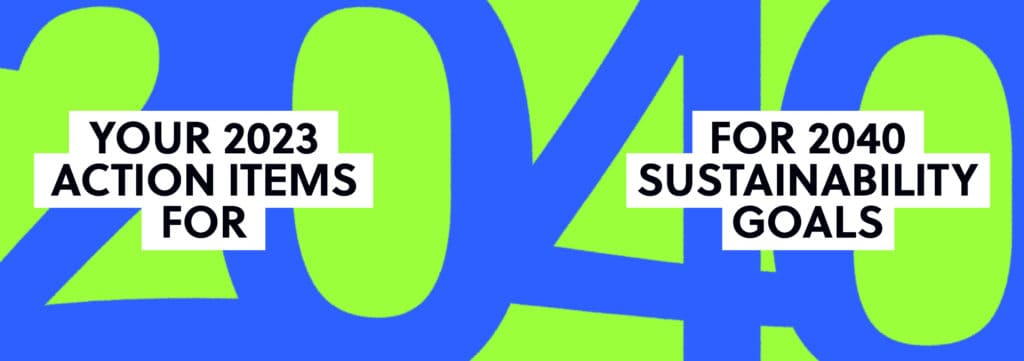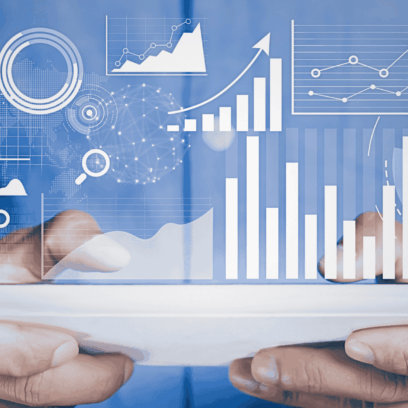How to Make Progress Toward Your Sustainability Goals


SUSTAINABILITY REPORTING OVERVIEW
Sustainability reporting serves as a valuable tool to achieve corporate commitments and better manage climate-related business risks. This white paper walks you through what’s typically included and what should be considered.
Outlining actionable steps for businesses to achieve sustainability targets through continuous progress, strategic milestones, and timely adaptation.
As the consequences of climate change now affect one in three people worldwide through extreme weather events, there has been a marked rise in climate-related regulations. Two proposed rules, the Federal Supplier Climate Risks and Resilience Rule and the SEC Climate Disclosure Rule, could have significant implications for businesses in the United States (US) if implemented. Additionally, the European Union (EU) has already passed the Corporate Sustainability Reporting Directive (CSRD) Rule, which will impact some US businesses in the near future. (We have a webinar that provides basic info that you should know about these regulations.) This upsurge in regulatory pressure, combined with the growing demands from consumers, employees, investors, and other stakeholders, has led companies to establish net-zero targets in the coming decades as a testament to their dedication to fighting climate change.
However, setting a net-zero target for a date in the future does not imply that action can be postponed until that time. While some companies may publicly promote sustainability as a marketing strategy, delivering on such claims requires substantial time, effort, and resources. Whether driven by voluntary action or regulatory requirements, it is crucial for companies to assess their environmental impacts, establish decarbonization targets, and monitor their progress toward achieving these goals. By doing so, they can ensure success in meeting their sustainability goals while minimizing potential reputational or compliance risks and avoiding “greenwashing.”
Why Sustainable Business Practices Matter Now
Protecting our planet is not only crucial but can also benefit your bottom line. We firmly believe that taking action on sustainability initiatives can be good for business, as they often yield returns on investment (ROI) in the form of reduced energy costs and increased market share. Regardless of whether you have already set a public decarbonization target, there are numerous reasons to promptly consider taking action to reduce your environmental impact.
These reasons may include competitive pressure, customer demands, the pursuit of operational efficiencies, future-proofing your business, risk mitigation, or simply a passion for preserving our planet. In the following sections, we will delve into some of the most common motivations for taking action on sustainability.
Stay Ahead of the Competition
As more companies embrace sustainability, those that lag behind risk losing market share and customer loyalty. A NielsenIQ survey revealed that climate change is a primary concern for consumers, with 45% of respondents considering it a significant issue. Additionally, 17% of consumers prefer to purchase products from environmentally sustainable brands. By adopting eco-friendly practices early, businesses can position themselves as industry leaders, attracting environmentally conscious consumers and investors. Proactively embracing sustainability can provide your organization with a competitive edge and help you stay ahead as regulations and consumer preferences evolve. By implementing sustainable practices and effectively communicating them, businesses can capitalize on the rising consumer demand for environmentally responsible products and services.
Operational Efficiency and Cost Savings
Incorporating sustainable practices can result in considerable cost savings through reduced energy consumption, minimized waste, and more efficient operations. The adoption of energy-efficient technologies, like LED lighting and smart thermostats, can not only decrease utility bills but also shrink your carbon footprint. Furthermore, waste reduction initiatives, including recycling and embracing a circular economy approach, can help your business save money while lessening its environmental impact.
Future-Proof Your Business
Acting on sustainability now can enable your organization to mitigate risks linked to climate change, resource scarcity, and evolving regulations. By proactively tackling these challenges, you can ensure that your business is well-equipped for the future and adaptable to emerging obstacles. Moreover, showcasing a dedication to sustainability can help attract and retain top talent, as employees are increasingly drawn to organizations that align with their values.
Navigate the Regulatory Landscape
As global climate regulations evolve, businesses must remain informed and adapt to new requirements. Proactively implementing sustainable practices can help your organization avert potential fines and penalties for non-compliance. Keep yourself up-to-date with current and proposed regulations in your region, such as the EU’s CSRD, the US Federal Supplier regulations, and SEC regulations, and ensure that your sustainability strategy is in line with these guidelines.
“Taking action now not only benefits the environment but also bolsters your organization’s reputation, resilience, and bottom line.”
Nicole Sullivan, former Director of Climate Services

Your Action Items for 2040 Net-Zero
Over 702 companies on the Forbes 2000 have made net-zero pledges. Whether your organization has made a pledge or plans to make one soon, there's a massive difference between pledging net-zero and achieving it. Do you have a clear roadmap for your sustainability journey? What are the right steps to consider to achieve 2040 net-zero carbon, water, and waste goals? It's time to create a clear roadmap.
The Importance of Sustainability Milestones
For significant progress toward sustainability, your organization should set well-defined decarbonization goals and establish milestones to monitor progress. This strategy enables you to break the journey into manageable segments, maintaining consumer engagement and information flow while effectively allocating resources. Consider developing credible and ambitious targets in line with the latest climate science, which can be submitted for approval by the Science Based Targets initiative (SBTi). Even if you opt not to have your targets officially approved by SBTi, their framework can still serve as a valuable guide for setting realistic and impactful goals.
Taking the First Steps Toward Sustainability
To initiate your sustainability journey, start by evaluating your organization's current standing and familiarizing yourself with any potential regulatory drivers that may be applicable. Perform a materiality assessment to pinpoint the environmental aspects most pertinent to your business, and utilize this information to shape your strategy.
1. Measure and Report Environmental Impacts for a Baseline Year
Begin by setting a baseline for your organization's environmental impacts, which involves measuring your carbon footprint and other relevant metrics, such as water consumption and waste generation. This process may require hiring new personnel, leveraging third-party resources, and/ or establishing systems to collect and manage data. Quantify your emissions intensity and utilize this information to guide your sustainability strategy. Share your first sustainability report to showcase transparency and dedication to your stakeholders.
2. Set Targets and Develop a Comprehensive Sustainability Strategy
After gaining a clear understanding of your organization's environmental impacts, establish targets and devise a comprehensive strategy to attain them. This may involve setting SBTi-aligned objectives, involving suppliers to tackle Scope 3 emissions, and investigating opportunities for direct decarbonization activities. Assess offset options for harder-to-abate emissions and integrate them into your plan.
3. Track Progress and Adapt Over Time
While executing your sustainability strategy, consistently track your progress and compare your current emissions to your established targets. Release annual sustainability reports to keep stakeholders informed and maintain accountability. Be ready to revise and adapt your strategy as necessary, acknowledging that sustainability is a non-linear journey that evolves alongside your operations, regulations, and technological advancements.
Conclusion
The importance of addressing climate change and achieving sustainability goals is paramount. By taking action today, your organization can stay ahead of the competition, enhance operational efficiency, mitigate risks, and contribute to a more sustainable future. By assessing your environmental impacts, setting ambitious decarbonization targets, and executing a comprehensive sustainability strategy, you can ensure your business thrives amidst evolving challenges and plays a crucial role in combating climate change. Keep in mind that taking action now not only benefits the environment but also bolsters your organization's reputation, resilience, and bottom line. No matter where you are in your sustainability journey, we can help. Contact us today to get started.
Your company might set sustainability milestones such as achieving a specific percentage reduction in greenhouse gas emissions by a certain date, implementing energy-efficient technologies like LED lighting or smart thermostats within a set timeframe, reaching a specific waste diversion rate or recycling percentage by a certain year, increasing the use of renewable energy sources to a predefined level by a target date, or establishing partnerships with suppliers who share your sustainability goals within a specific period.
Your first sustainability report should showcase transparency and dedication to stakeholders. Include your baseline environmental impacts, decarbonization targets, and an overview of your comprehensive sustainability strategy. Also, address any regulatory requirements that apply to your business.
To involve suppliers in addressing Scope 3 emissions, you can communicate your sustainability goals and expectations clearly, emphasizing the importance of collaboration, provide resources, guidance, and support to help suppliers develop and implement their own sustainability initiatives, and share best practices, tools, and relevant information to assist suppliers in reducing emissions. Establishing a supplier code of conduct that outlines sustainability requirements can also help.
If a supplier is unwilling to participate in sustainability efforts, consider engaging in a dialogue to understand their concerns and identify potential barriers to participation. Offer incentives, such as preferred supplier status or long-term contracts, to encourage their involvement. If the supplier remains uncooperative, re-evaluate your relationship with them and consider sourcing from alternative suppliers that share your sustainability values and goals.


